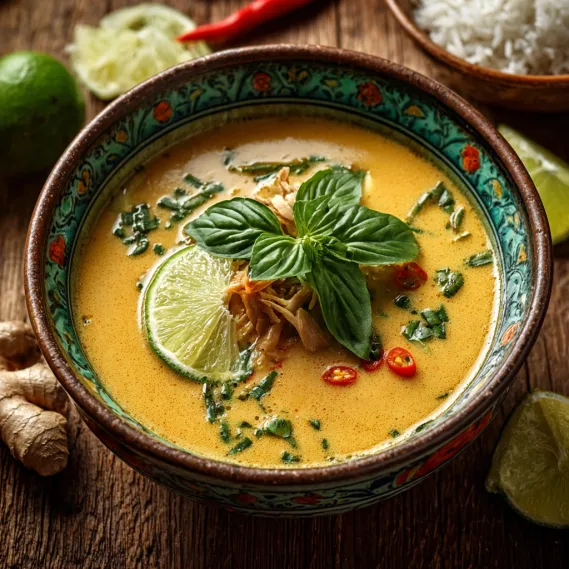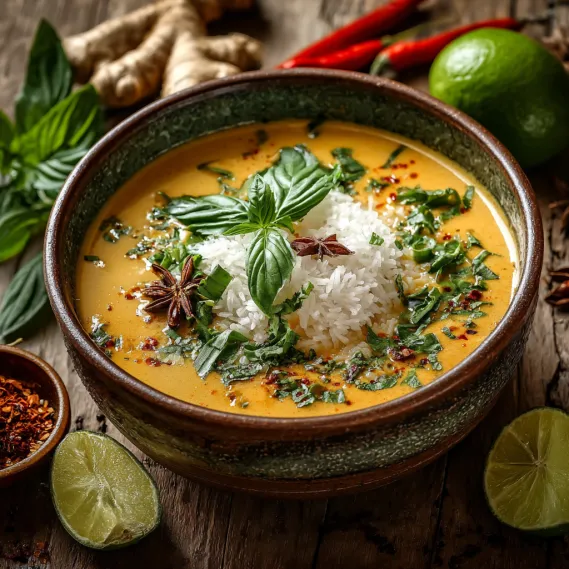 Pin
Pin
This Thai coconut curry sauce transforms ordinary ingredients into an extraordinary meal with its perfect balance of sweet, spicy, and savory elements. A staple in my kitchen for years, this versatile sauce brings the vibrant flavors of Thailand straight to your dinner table without complicated techniques.
I discovered this recipe during my experimentation with Southeast Asian cooking techniques and it quickly became my secret weapon for impressing dinner guests. Even my spice-cautious friends request this sauce regularly, as the heat level can be easily adjusted.
Ingredients
- Coconut oil: adds authentic Thai flavor while providing the perfect medium for blooming spices
- Organic shallots: offer a milder, sweeter foundation than regular onions
- Fresh garlic cloves: provide essential aromatic base
- Grated fresh ginger: brings warm spicy notes that dried cannot match
- Red curry paste: delivers complex flavor without requiring dozens of individual spices
- Full fat coconut milk: creates the luxurious creamy texture central to the dish
- Fish sauce: provides that essential umami depth authentic to Thai cuisine
- Palm sugar: balances the heat with traditional caramel notes
- Thai basil leaves: contribute distinctive anise flavor that regular basil cannot replicate
- Fresh lime juice: brightens all flavors and adds crucial acidity
Step-by-Step Instructions
- Sauté The Aromatics:
- Heat coconut oil in a large saucepan over medium heat until it shimmers but doesn't smoke. Add finely chopped shallots and cook them slowly, stirring occasionally until they become translucent and fragrant. This takes approximately 2 to 3 minutes and creates the aromatic foundation for the entire sauce.
- Bloom The Spices:
- Add minced garlic and grated ginger to the softened shallots, stirring constantly to prevent burning. Cook for exactly one minute until the kitchen fills with their intoxicating aroma. This step releases the essential oils in these ingredients, amplifying their flavors throughout the sauce.
- Develop The Curry Base:
- Add red curry paste to the aromatic mixture and stir continuously for 2 full minutes. This critical step activates the dried spices within the paste, allowing them to bloom and develop their full flavor potential. The mixture will become intensely fragrant and slightly darker as the spices toast.
- Create The Sauce:
- Pour in the coconut milk in a slow, steady stream while stirring to incorporate it smoothly with the curry base. Add fish sauce and palm sugar, stirring gently until the sugar completely dissolves. Bring the mixture to a gentle simmer, maintaining a temperature just below boiling. Allow it to cook uncovered for 15 minutes, stirring occasionally as the sauce thickens and the flavors marry together.
- Finish With Fresh Elements:
- Remove the saucepan from heat completely before adding the Thai basil leaves and freshly squeezed lime juice. Stir these final ingredients in gently just before serving to preserve their bright, fresh flavors which would diminish with extended cooking.

This sauce truly comes alive with fresh lime juice added at the very end. The first time I served this at a family gathering, my uncle who lived in Thailand for several years claimed it transported him straight back to the streets of Bangkok. That moment cemented this recipe as a cherished part of our family cookbook.
Storage Solutions
Your coconut curry sauce will keep beautifully in an airtight container in the refrigerator for up to 5 days. The flavors actually continue to develop and harmonize during storage, making this an excellent make ahead option. For longer preservation, freeze portions in ice cube trays then transfer to freezer bags. These curry cubes will maintain their quality for up to 3 months and can be thawed directly in the pan when cooking. Just remember that upon reheating, you may need to refresh the sauce with a squeeze of lime juice to revive its bright notes.
Versatile Applications
This sauce serves as a magnificent foundation for countless meals beyond traditional curry. Drizzle it over grilled fish or chicken for an instant flavor upgrade. Use it as a simmer sauce for tofu or vegetables for a quick weeknight dinner. Try it as a marinade for proteins before grilling for an unexpected depth of flavor. My personal favorite adaptation involves using it as a cooking liquid for jasmine rice, allowing the grains to absorb the complex curry flavors as they cook. You can even thin it slightly with additional coconut milk to create a unique salad dressing that will transform ordinary greens into something extraordinary.
Dietary Adaptations
This recipe accommodates various dietary needs with simple modifications. For vegetarians and vegans, substitute the fish sauce with tamari, coconut aminos, or quality soy sauce to maintain that crucial umami element. Those avoiding sugar can replace the palm sugar with a teaspoon of coconut sugar or a natural sweetener like monk fruit. If following a low fat diet, light coconut milk can be used, though the sauce will be thinner and less rich. For keto adherents, use a keto friendly sweetener and pair the sauce with appropriate proteins and vegetables. Those with nightshade sensitivities might try yellow curry paste instead of red, as it often contains less capsaicin while still delivering wonderful flavor.
Common Questions About This Recipe
- → What makes this sauce authentically Thai?
Ingredients like coconut milk, red curry paste, Thai basil, and fish sauce are signature elements in Thai cooking, creating a balance of sweet, spicy, salty, and aromatic flavors.
- → Can I make it vegetarian-friendly?
Absolutely! Substitute fish sauce with soy sauce for a fully plant-based option, and ensure your curry paste is vegetarian.
- → How spicy is this sauce?
The spiciness depends on the amount of red curry paste used. Adjust it to taste for a milder or bolder heat profile.
- → What dishes pair well with this sauce?
It pairs beautifully with grilled prawns, sautéed vegetables, tofu, or as a finishing sauce over jasmine rice or noodles.
- → How can I thicken the sauce?
Simmer the mixture longer to reduce the coconut milk, resulting in a thicker, richer consistency without additional thickeners.
